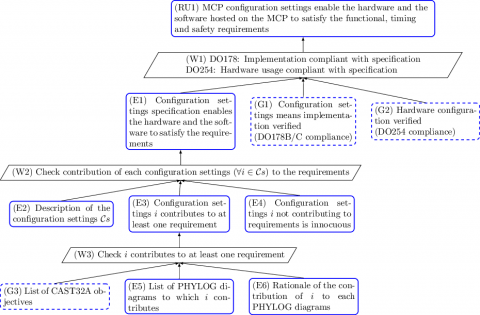The applicant has determined and documented the MCP configuration settings that will enable the hardware and the software hosted on the MCP to satisfy the functional, performance, timing and safety requirements of the system.
The first objective (RU1) is the core of the CAST-32A: the objective is to define precisely the configuration settings, that is the way the multi-core is used and configured by the applicant, and why such a configuration is compliant with the overall CAST-32A. In effect, the pattern here above traces the reasoning. On the top, we recognize the objective. The configuration settings are obtained with hardware procedures, but also with software and registers configuration. This means that software development are involved to ensure the configuration. Thus, the configuration has been designed (E1) and well implemented (G1). Let us now focus on the design itself (E1).
The configuration settings have been well and completely chosen if the applicant has checked the configuration settings and how they contribute to the CAST-32A requirements (W2). To make the (W2) activity, the applicant needs the full description of the configuration settings (E2), in which other PHYLOG patterns each of the settings appears (E3) and for those which do not appear in any other PHYLOG pattern, an argument that the settings will not impact the safety of the multi-core (E4). (E3) is refined as a subpattern meaning that it results from the activity (W3) where the applicant checks that the configuration setting contributes to at least one pattern. This activity (W3) relies on three inputs: the knowledge of the CAST-32A requirements (G2), the list of the PHYLOG patterns where the configuration setting contributes (E5) and a rationale for each contribution of why the settings is relevant.

